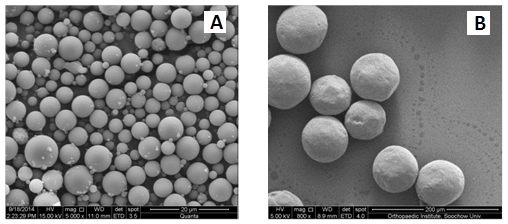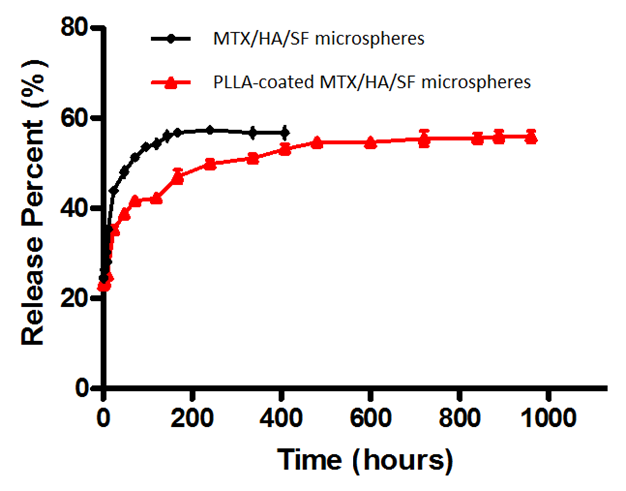Introduction: Chemotherapy is commonly used after surgical resection of giant cell tumor to prevent its recurrence. Filling with osteogenic material together with chemotherapy drugs in tumor cavity is a promising way to eliminate tumor cells and promote new bone formation simultaneously. In this study, we prepared osteogenic hydroxyapatite (HA) and silk fibroin (SF) complex microspheres and used them as a drug delivery system. In order to reduce the burst release and extend the drug release time, the HA/SF microspheres were coated with polylactic acid (PLLA).
Materials and Methods: Ca(NO3)2 was added into an 8% silk fibroin(SF) aqueous solution (Solution A, pH=9). Methotrexate (MTX) was added into a (NH4)2HPO4 aqueous solution (Solution B, pH=9). The solutions A and B were added dropwise into paraffin successively under continuous stirring to prepare MTX-loaded HA/SF microspheres (MTX/HA/SF). Following that, the microspheres were added into a solution of PLLA in dichloromethane. Then the mixture was subject to alternated stirring and ultrasonication to form homogeneous s/o oil slurry. The slurry was added under stirring into a PVA aqueous solution to form the s/o/w emulsion. After 4h of stirring to remove the organic solvent, the solidified microspheres were collected. The drug release characteristics were tested in vitro, and cell proliferation was checked using MG-63 and osteoblast cells.
Results and Discussion: MTX/HA/SF microspheres and PLLA-coated MTX/HA/SF microspheres with relatively uniform size and good sphericity were successfully prepared by combining emulsion-solvent evaporation and co-precipitation techniques (Figure 1). The diameter of MTX/HA/SF microspheres could be controlled by changing the concentration of SF solution and stirring speed. The diameter of PLLA-coated MTX/HA/SF microspheres increased with PLLA concentration. FTIR and XRD tests confirmed the formation of HA crystals and effective loading of MTX in both types of microspheres. Compared to the HA/SF microspheres, the PLLA-coated MTX/HA/SF microspheres showed reduced burst release and significantly extended release time (Figure 2).

Figure 1. SEM images of (A) MTX/HA/SF microspheres and (B) PLLA-coated MTX/HA/SF microspheres, respectively.

Figure 2. Drug release profiles of MTX-loaded HA/SF microspheres in vitro at 37 ºC.
Conclusion: In summary, MTX-loaded HA/SF microspheres with good drug package efficiency were successfully prepared. After further coating with PLLA, the microspheres showed low burst release and long-term release capability. Being composed of osteogenic materials and chemotherapy drugs, such a microsphere system is expected to prevent rejuvenation of tumor and in the mean time, to promote bone defect repair.
National Natural Science Foundation of China (81171479, 51303120, 81471790); Jiangsu Provincial Special Program of Medical Science (BL2012004); Natural Science Foundation of Jiangsu Province (BK20130335)